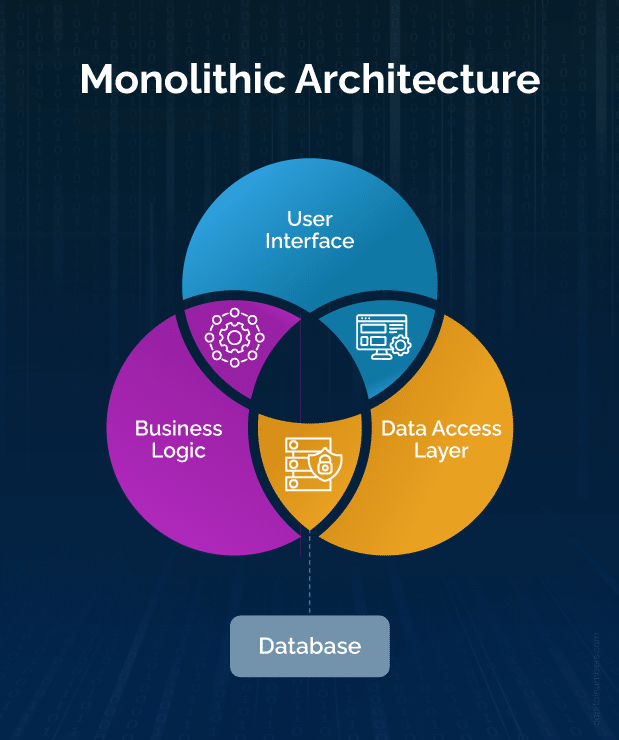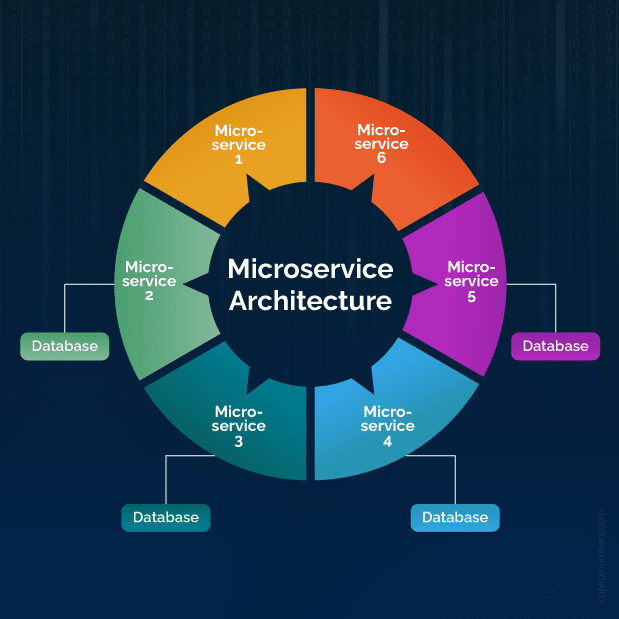[ad_1]
Software program improvement is regularly shifting and repositioning, and each group is in quest of the subsequent smartest thing that may improve the velocity, scalability, and maintainability of their functions. In the previous couple of years, a brand new architectural sample has gained appreciable recognition – microservices structure. This architectural type is a really attention-grabbing complement to classical monolithic architectures because it claims to be way more environment friendly and versatile in constructing and deploying software program functions.
Transient Overview of Monolithic Structure
Monolithic constructions aren’t uncommon in utility framework designs. There are situations the place all elements have been constructed and built-in collectively, even at a really core stage, into one system that manages nearly all of features or processes. This preliminary structure could present easy improvement for the preliminary stage, however as a result of following causes, the appliance’s progress renders this structure insufficient:
- Sluggish Improvement: The rise within the code base leads to extra builders becoming a member of the system; therefore, making an attempt to change the prevailing system proves to be a posh activity that extends improvement time frames.
- Deployment Difficulties: The slightest modification adjustments something within the system; consequently, most individuals need to try to deploy the complete system, which may be very pricey and in some methods dangerous.
- Scalability Points: Deploying extra sources to scale a monolith usually means each single connecting facet of that utility must be utilized moreover, whether or not or not the opposite elements require it.
- Expertise Lock-in: Nothing prevents individuals from creating each part of the appliance on a distinct expertise; nevertheless, generally, it isn’t finished. It’s usually the case that this was finished simply from the start; there have been no new applied sciences adopted afterwards.

Definition of Microservices Structure
Microservices structure mitigates these points by splitting the massive utility into a number of companies which might be loosely coupled. Every service is centered round discrete enterprise performance and is developed, deployed, and scaled independently. This design has a number of benefits, that are as follows:
- Improved Scalability: Providers may be scaled individually for his or her particular wants.
- Sooner Improvement: Targeted companies serve narrower performance and due to this fact are simpler to grasp and alter, leading to sooner improvement.
- Simplified Upkeep: Distributing logic into separate companies reduces its upkeep burdens and the opportunity of a change impacting the whole system.
- Expertise Flexibility: Varied companies may match with totally different applied sciences, that means that groups would use the very best match for every function.

Key Parts of Microservices Structure
For accelerated and improved use of microservices, a number of crucial components should be put in place, like:
- Service Discovery: Service Discovery can be known as dynamic service registration; this service is particularly essential in microservices because it permits multi-dimensional communication and visibility between microservices. Providers are self-registered and uncover different companies with out community areas utilizing service discovery mechanisms resembling Netflix Eureka or Consul.
- API Gateway: An API Gateway refers to a single interface or entry level by which requests from purchasers are processed. It’s chargeable for routing, safety, and fee limiting. It hides the complexity of microservice utility structure from the completed consumer. API Gateway and Anthem are extensively used examples.
- Service Mesh: A service mesh is an extra layer built-in into the appliance. It manages communication between companies the place purchasers don’t straight work together. It contains options like visitors management, safety, and observability. This contains Istio and Linkerd.
- Containerization: Containerization permits us to make use of a set of companies embedded with their dependencies in remoted containers. This improves deployment and scaling along with guaranteeing uniformity all through varied environments.
- Orchestration: Orchestration of containers, for instance, utilizing Kubernetes, issues itself with the administration of deployment, scaling, and operation of loaded container companies. It offers with gadgets resembling load balancing, service discovery, or rolling updates.
Advantages of Microservices Structure
Microservices structure has a number of advantages, together with:
- Scalability: Particular person companies may be scaled independently and primarily based on demand, enabling higher useful resource utilization.
- Agility: Smaller, centered companies result in faster improvement cycles adopted by simpler adjustments.
- Resilience: The failure of 1 service may be contained in that service and won’t essentially take down the entire utility.
- Expertise Heterogeneity: Varied applied sciences may be employed to finish varied companies, permitting the groups to pick out the very best expertise for the duty.
- Group Autonomy: Small and impartial groups can personal and develop companies, resulting in swift decision-making and speedy improvement.
Challenges and Concerns
Though microservices have many benefits, in addition they have their disadvantages:
- Elevated Complexity: Deploying many companies and integrating the companies may be extra complicated than having a single utility in a single unit.
- Distributed Techniques Challenges: Community latency, consistency of information, and tolerance of faults turn into straightforward to identify however troublesome to handle in an structure that’s distributed.
- Testing and Debugging: Elevated elements and an elevated variety of interactions imply that the testing and debugging of dispersed techniques are sophisticated.
- Knowledge Administration: Knowledge and its consistency and transactions that spanned throughout and inside many companies needed to be managed.
Greatest Practices for Microservices Structure
With regards to microservices, there are explicit greatest practices aimed toward rising the advantages whereas reducing the difficulties related to microservices:
- Area-Pushed Design: Establish the enterprise area of the service to attract the traces separating totally different companies and their tasks.
- Unfastened Coupling: Scale back the interdependence of companies so that anyone service may be designed and deployed with out the others being affected.
- Bounded Contexts: Enclose a service or a cluster of associated options and knowledge inside a transparent boundary.
- Occasion-Pushed Structure: Moderately than enabling interservice calls, make use of occasions to switch data between companies.
- Steady Integration and Supply (CI/CD): Every microservice ought to have automated testing, constructing, and deployment processes.
- Monitoring and Observability: Use enhanced logging and monitoring to help in drawback estimation and their fast decision.
You Could Additionally Learn: Accelerating Software program Supply: DevOps Greatest Practices for CTOs
Conclusion
Microservers have turn into actually in style in customized software program improvement as they provide the power to be speedy, responsive, and simple to construct and keep. For any firm, it permits them to interrupt down functions into smaller, impartial functions that may lead to higher utility replace speeds and a wider vary of applied sciences out there for them.
However there’s additionally a caveat with microservices in that one can’t merely use them for something and every little thing. It requires the group to evaluate their necessities clearly to determine whether or not or not making use of microservices goes to suit them.
With the microservices department being new, it’s predicted that new improvements can stem from its integration into serverless architectures, edge computing, and even higher orchestration instruments. All of this stuff can enhance the best way functions have been constructed earlier than by streamlining the method of constructing distributed techniques, giving the person the power to do extra issues in much less time.
It’s, nevertheless, suggested to solely incorporate microservices one after the other and start the transition from a monolithic microservice. This will help in constructing and understanding the structure, as that may carry the bottom danger.
It’s attention-grabbing to notice that the general success of implementing microservices is decided by the extent of preparations undertaken beforehand, the deployment and adherence to the ideas that underlie the structure, and the acceptance of excellent practices with respect to each software program improvement and operations.
[ad_2]

